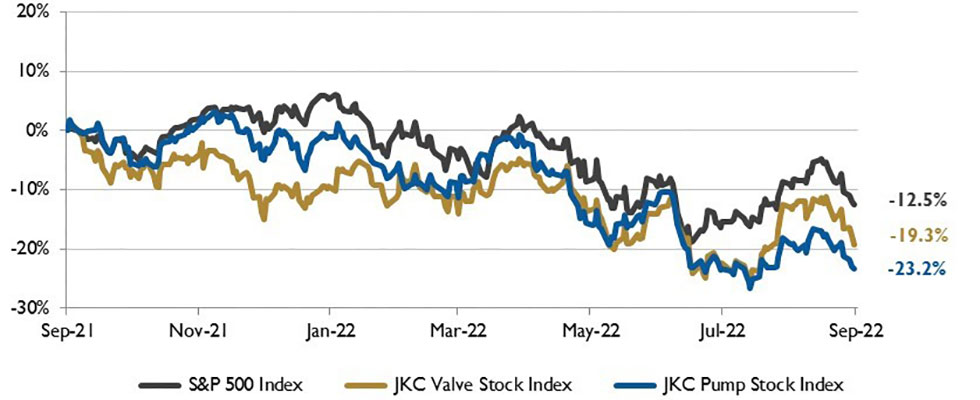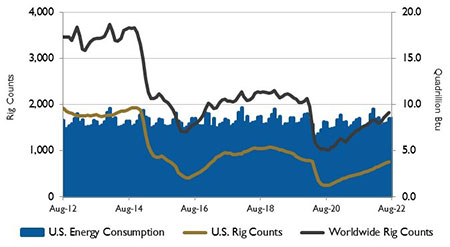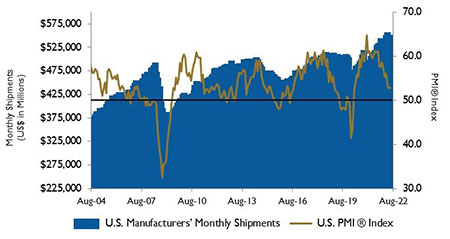
The Jordan, Knauff & Company (JKC) Valve Stock Index was down 19.3% over the last 12 months, and the broader S&P 500 index was down 12.5%. The JKC pump stock index fell 23.2%.1
The Institute for Supply Management’s Purchasing Managers Index (PMI) did not change and remained at 52.8% in August. New orders gained 3.3 percentage points to put the measure back into expansion territory at 51.3%. Order backlogs improved, rising to 53.0%.

Local currency converted to USD using historical spot rates. The JKC Pump and Valve Stock Indices include a select list of publicly traded companies involved in the pump & valve industries, weighted by market capitalization. Source: Capital IQ and JKC research.
The Production Index fell 3.1 percentage points to 50.4%; barely in expansion. The Employment Index rose 4.3 percentage points to 54.2%, the best number since March.

Source: U.S. Energy Information Administration and Baker
Hughes Inc.
The Prices Index fell 7.5 percentage points to 52.5%, the lowest point for this component since June 2020.
Amid concerns about slower growth for the global economy, the Export Orders Index slipped into contraction territory, falling to 49.4%. One survey respondent in the transportation segment said that “the chip shortage is slowing.”
The U.S. Bureau of Labor Statistics reported total nonfarm payroll employment increased by 315,000 jobs in August, and the unemployment rate rose to 3.7%. Notable job gains occurred in professional and business services, healthcare and retail trade.
However, this marked the lowest monthly jobs gain since April 2021. July’s data was revised downward to 526,000 from 528,000 reported earlier. Similarly, June’s data was revised downward to 293,000 from 398,000 reported earlier.
Manufacturing employment continued to trend up, gaining 22,000 jobs, with increases in durable goods industries of 19,000. Manufacturing has added 461,000 jobs over the year.
The U.S. Energy Administration forecasts that OPEC revenues will be nearly 50% higher in 2022 than in 2021. Members of OPEC collectively are predicted to earn $842 billion in revenues from oil exports in 2022, the most (adjusted for inflation) for the group since 2014.

Source: Institute for Supply Management Manufacturing Report
on Business and U.S. Census Bureau
The revenue increase this year would be due to both more production and higher crude oil prices. In 2023, it is forecast that OPEC liquid fuels production will rise to 34.5 million barrels per day (b/d), which is 570,000 b/d more than forecast for 2022. Despite the forecast rise in production, it is anticipated that OPEC net revenues will fall in 2023 due to lower global crude oil prices.
On Wall Street, the Dow Jones Industrial Average and the S&P 500 Index fell 4.1% and 4.2%, respectively, while the Nasdaq Composite lost 4.6% in August. Federal Reserve Bank Chairman Jerome Powell and other top Federal Bank officials have indicated that the rigorous rate hikes will continue until inflation is at least down to near its 2% target rate.
Investors were hoping for a rate cut next year, which looks like a remote possibility. Market participants are concerned about a recession in the U.S. economy in the near future.

